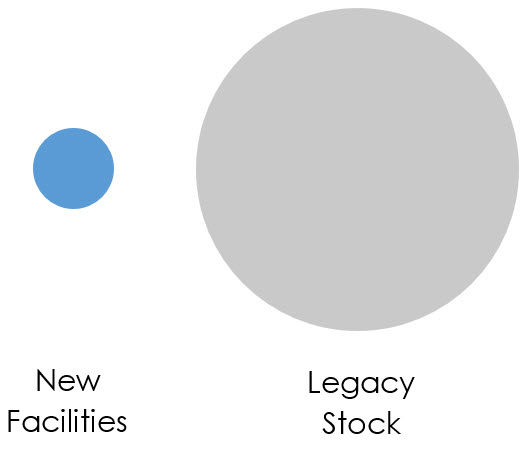
The 5 Ingredients for a Breakthrough in Facilities Data
Director at Enstoa, Inc.
For most building owners, navigating information about their facilities is much like picking up a copy of The Thomas Guide from 2000. You first have to locate the physical book (no, you can’t download the ebook), then hope that the information pertaining to your origin and destination have not changed. Similarly, in the case of facilities, you first have to find the blueprints, CAD drawings, Building Information Models (BIM), and/or asset spreadsheets, and again hope that any changes made since the creation of the document have been incorporated in a consistent format, following clearly defined data standards. If you are lucky enough to find what you are looking for, cross your fingers and hope that you have the necessary software to view the information.
Luckily for all of us, GPS systems have saved the day when it comes to finding our way around cities we have never visited. Unfortunately, building owners have not had such breakthroughs in the world of facilities systems. This remains a constant struggle to find basic and reliable information essential to operate, maintain, and enhance buildings and assets that have existed for many years. Based on our research and work with clients, we have established 5 key ingredients necessary for owners to create such breakthroughs:
1. Implement rigorous facilities data governance:

Basic services contracts governing capital projects and facilities improvements do not address the implementation of and adherence to comprehensive data standards. Even if partners were to agree with this requirement, owners are left with the tedious task of validating the compliance of the digital deliverables with data standards.
2. Select appropriate software:
Capital projects design and construction professionals use different platforms to author digital drawings and models. In many cases, facilities owners end up investing in multiple niche software tools just to keep their drawings or models current. However, most of these tools don’t provide easy access to the information they need.
3. Extensive software training:
Power users may have to undergo extensive training in expert tools to keep design and construction information updated. This limits stakeholders’ access to information; they remain dependent on trained resources to make use of rich facilities data.
4. Multi-year digitization effort:

The vast majority of building owners’ portfolios precede the widespread implementation of BIM, CAD, IWMS, and CAFM systems. Digitizing the “legacy building stock” is a large and time consuming effort, but necessary in today’s digital world, especially when looking to leverage information tied to the full life cycle of an asset.
5. It’s not just about new construction:

Remodel projects generally constitute a large portion of an owner’s capital plan. Most attempts to solve the facilities data challenge have focused on new construction. Little attention has been given to the larger majority of capital projects for remodeling existing facilities, where access to existing facilities information in a timely fashion could mitigate project risks and provide certainty in scope and cost estimating.
With the digitization of building and facilities documentation, capital projects and facilities stakeholders need capabilities and solutions to make good use of this information. Owners need a strategic approach with the right combination of these 5 ingredients to empower them to truly know, operate, maintain, and enhance their facilities.
Mo Haidar is a Director at Enstoa, the leading systems integrator for capital projects worldwide. Follow Mo on Twitter at twitter.com/haidarmo.
For most building owners, navigating information about their facilities is much like picking up a copy of The Thomas Guide from 2000. You first have to locate the physical book (no, you can’t download the ebook), then hope that the information pertaining to your origin and destination have not changed. Similarly, in the case of facilities, you first have to find the blueprints, CAD drawings, Building Information Models (BIM), and/or asset spreadsheets, and again hope that any changes made since the creation of the document have been incorporated in a consistent format, following clearly defined data standards. If you are lucky enough to find what you are looking for, cross your fingers and hope that you have the necessary software to view the information.
Luckily for all of us, GPS systems have saved the day when it comes to finding our way around cities we have never visited. Unfortunately, building owners have not had such breakthroughs in the world of facilities systems. This remains a constant struggle to find basic and reliable information essential to operate, maintain, and enhance buildings and assets that have existed for many years. Based on our research and work with clients, we have established 5 key ingredients necessary for owners to create such breakthroughs:
1. Implement rigorous facilities data governance:

Basic services contracts governing capital projects and facilities improvements do not address the implementation of and adherence to comprehensive data standards. Even if partners were to agree with this requirement, owners are left with the tedious task of validating the compliance of the digital deliverables with data standards.
2. Select appropriate software:
Capital projects design and construction professionals use different platforms to author digital drawings and models. In many cases, facilities owners end up investing in multiple niche software tools just to keep their drawings or models current. However, most of these tools don’t provide easy access to the information they need.
3. Extensive software training:
Power users may have to undergo extensive training in expert tools to keep design and construction information updated. This limits stakeholders’ access to information; they remain dependent on trained resources to make use of rich facilities data.
4. Multi-year digitization effort:

The vast majority of building owners’ portfolios precede the widespread implementation of BIM, CAD, IWMS, and CAFM systems. Digitizing the “legacy building stock” is a large and time consuming effort, but necessary in today’s digital world, especially when looking to leverage information tied to the full life cycle of an asset.
5. It’s not just about new construction:

Remodel projects generally constitute a large portion of an owner’s capital plan. Most attempts to solve the facilities data challenge have focused on new construction. Little attention has been given to the larger majority of capital projects for remodeling existing facilities, where access to existing facilities information in a timely fashion could mitigate project risks and provide certainty in scope and cost estimating.
With the digitization of building and facilities documentation, capital projects and facilities stakeholders need capabilities and solutions to make good use of this information. Owners need a strategic approach with the right combination of these 5 ingredients to empower them to truly know, operate, maintain, and enhance their facilities.
Mo Haidar is a Director at Enstoa, the leading systems integrator for capital projects worldwide. Follow Mo on Twitter at twitter.com/haidarmo.
